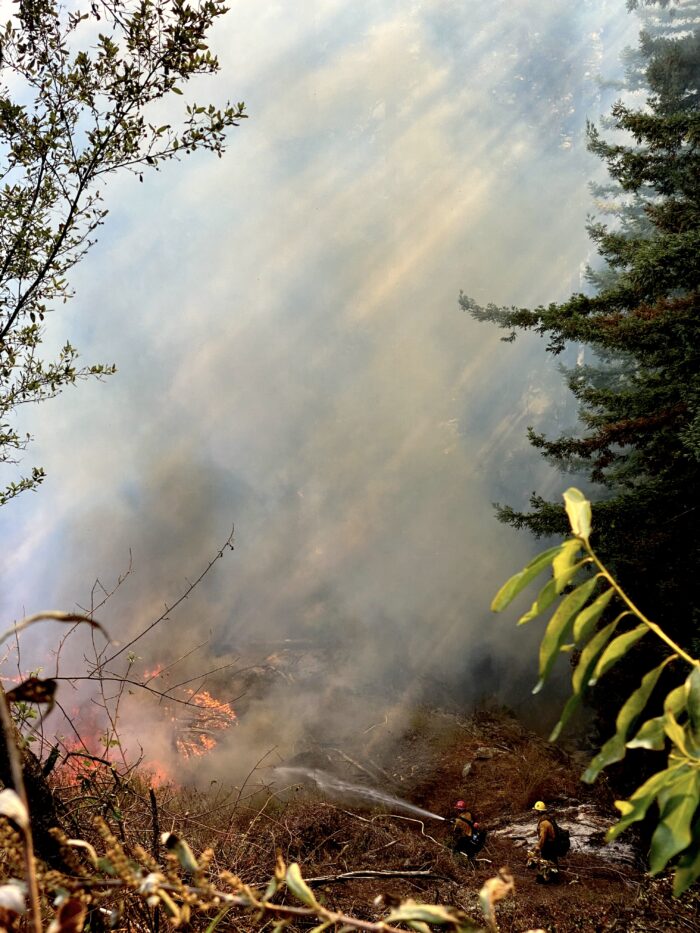
Courtesy of Jordan Thomas

Courtesy of Jordan Thomas
In late August, before dawn broke on a foggy California morning, I marched with a crew of wildland firefighters through a redwood forest. We crossed a small farm, the jostle of our footsteps joining the cries of sheep and chickens as a man and woman paused to watch us pass. A mile in, we found the Dolan Fire creeping close to the ground through the underbrush, as if lying in wait for the coming heat wave that would cause it to rear up, devour the forests, and throw plumes of smoke like smoldering thunderclouds overhead. But that wouldn’t happen for several days yet. I put in my earplugs, started my chainsaw, and began cutting a fuel break around the fire’s edge. The rest of my crew followed close behind.
We were like ants crawling along the edge of a fiery expanse, just twenty among the 14,000 firefighters battling the blazes that have consumed a record four million acres in California this year. In August, the Forest Service closed National Forests across the state, citing “unprecedented” fire conditions. Unprecedented, but not unexpected: the confluence of extreme heat, low humidity, and high winds driving the current wildfires has created the precise recipe for disaster that scientists have predicted for forty years, ever since a scientific consensus emerged that carbon emissions drive climate change.
Back in January, eight months before the current crisis, I met with veteran firefighter John “Pancho” Smith to learn about the history of fires and firefighting. As a researcher and anthropologist, I imagined myself uncovering the ontological roots of fire suppression. But as a firefighter, I was both Pancho’s colleague and his subordinate. For the interview, I had packed my elk skin firefighting boots in the trunk of my Prius in case I was challenged to a hike.
Pancho welcomed me into a ranger station in Los Padres National Forest, tucked in a valley where coastal oak trees were still charred from a fire several years before. He smiled under a salt-and-pepper mustache as he took me back to the early 1970s, when he became a wildland firefighter at the age of sixteen. Back then, he said, you could tell them whatever age you wanted. By the time he was 20, helicopters would drop Pancho off in the wilderness to put out fires, returning in the morning to pick him up.
On one such mission, Pancho lost control of a fire and realized it was time to run. What had begun as a small blaze had transformed into a wall of flame, and Pancho was nearly surrounded.
“I just hauled ass up the hill,” he said. “I knew I’d be alright if I got to the top of the ridge.” Behind him, the fire grew and ignited the tops of trees like matchsticks. “When firefighters die in a forest fire,” explains sociologist Mathew Desmond, they inhale searing oxygen and “burn from the inside out.”
But Pancho knew he had a decent chance of escape: this was a standard wildfire, one of more than 60,000 which occurred throughout the United States each year. The flames climbed uphill with prevailing winds, avoiding previously burned areas, and calmed in the evening as the temperature dropped and humidity rose. Pancho could count on the flames to stop at a fuel break, like a road or rocky outcropping. That was fifty years ago, when wildfires still behaved in predictable ways.
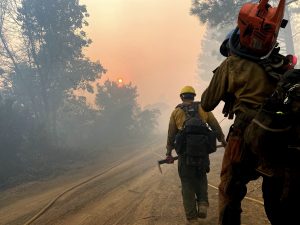
A year before the interview, when I first joined a wildland firefighting crew, I had expected the operation to be high-tech. This was California, the land of Silicon Valley and SpaceX, and I had seen the TV-ready images of low-flying aircraft spewing fluorescent retardant and helicopters thumping through the sky. But when I arrived at training, I was told to pick a tool.
Another would-be firefighter caught me eyeing a chainsaw.
“You gonna be a sawyer?” he asked.
“A what?”
“A sawyer. The guy with the chainsaw. You hike fast. You should do it.”
I learned that sawyers are paid an extra dollar per hour, and the matter was settled. My job was to lead the fire crew, cutting brush out of the path of the flames. The rest of the squad follows with hoes and axes, chopping, scraping, and scratching until a solid line of mineral soil separates the approaching fire from surrounding vegetation. Though wildfires are slowed by airdrops of retardant and water, they are contained by lines of humans wielding tools. To date, nothing has proven more effective.
“That part hasn’t changed much,” Pancho said, since he began fighting fires. It’s still just a group of people “scratching shit out of the way to move the fuels so the fire can’t burn any farther.”
What has changed, though, is the fires themselves. In the past half century, the amount of carbon in the atmosphere has increased by almost a third, warming temperatures in California and extending fire seasons by months. Before 2000, massive fires were relatively rare in the state. The following years have seen 17 of the 20 largest fires in California’s history. Of those fires, five of the six largest ever are burning as I write. Fires that, in Pancho’s youth, would have occurred only once in a century are burning nearly every year.
“They’re bigger now,” Pancho told me. “Seems like they’re bigger. Things are happening which never happened before.”
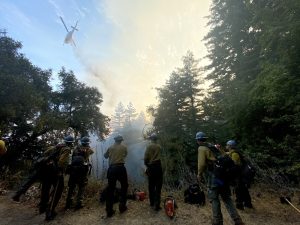
After three hours of cutting uphill, sweat soaked through the leather of my boots and my Kevlar chaps. The fifty-pound pack dug into my shoulders, so I was relieved when the chainsaw sputtered to a stop. I called for fuel and dropped to my knees to open the gas tank. A firefighter handed me two canisters before popping a salt pill in my mouth to replenish the nutrients I was sweating out. Water alone is often not enough to hydrate. When my sweat stops tasting salty, I know muscle cramps are coming.
I pulled the cord and the chainsaw screamed, reduced by my earplugs to a distant drone. Fire is a chemical reaction that occurs when fuels like wood are heated to their ignition points, releasing accumulated energy as flames. But it’s a mistake to imagine fire as a natural phenomenon divorced from human behavior. An artifact of cultural histories, fires are the “result of social relationships as much as ecological relationships,” as anthropologist Cynthia Fowler observes. Fires reflect the economic transformations of landscapes, as well as people’s domination of each other. Throughout California’s history, each cultural group has left its own imprint on the region’s fire ecology.
California’s colonial history of fire suppression began in 1793, when José Joaquín de Arrillaga, governor of the Spanish territory of Alta California, penned the first fire regulation of the American West. Outside his window, a road wound between dispersed oak trees and scattered farms downhill to the blue disk of the Pacific, where a harbor sheltered Spanish ships. Arrillaga would have seen the salty fog or golden light of a Santa Barbara day illuminating the Catholic church perched on a hill above.
The “childish” burning of fields, customary among Indigenous communities, was causing “widespread damage,” Arrillaga wrote. “I see myself required to have the foresight to prohibit for the future all kinds of burning.” He directed his administrators to “uproot this very harmful practice of setting fire to pasture lands,” and use “the most severe punishment” to enforce the policy.
When Europeans extended their reach across the oceans, bringing new diseases, economies, and plants, they also transported skewed perceptions of fire. Across the colonial world, controlling flames became a means of managing people. Woven into European legal codes since the Industrial Revolution, official fire bans joined a litany of other land use restrictions that forced people off of local farms and into systems of wage labor. Fire bans were effective tools of control because fire is often central to traditional food systems. Historically and around the world, many peoples have used fire to sustainably tend vegetation, enrich soil, and create verdant ecosystems that attract animals for hunting. The day that Arrillaga banned fire, he effectively criminalized the economic system of the Native Chumash peoples and tethered the Indigenous populations to the emerging ranching and plantation economies of the Spanish Empire.
Prior to the arrival of the Europeans, the use of fire pervaded everyday life for Indigenous Californians. When humans first arrived in the coastal area roughly 12,000 years ago, they found an environment that was already combustible. Over the course of millennia, the inhabitants gradually maneuvered this flammability to their advantage.
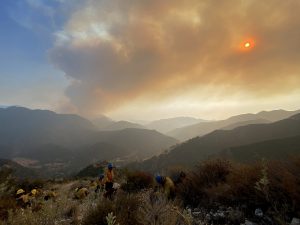
The forms of fire that emerged as a result of human management are as diverse as the people and ecology of Indigenous California. The Chumash peoples of the Central Coast set frequent, light fires, which, as ethnobotanist Kat Anderson has documented, not only limited the severity of wildfires, but also increased the abundance of edible plants and building materials. The resulting mosaic of hardwood forests, shrubs, and grasslands between the coast and the mountains invited animals to fill the landscape.
Fire was central to the cultural and environmental systems of the region, and its forceful removal proved jarring to both. By 1542, when Spanish ships first sailed up the coast and observed a pall of smoke over the landscape, California’s biological diversity had likely been enhanced by centuries of careful fire management. Europeans exploited that biological wealth with plows, livestock, and saws — all the while imagining themselves to be building civilization from untrammeled wilderness.
In the words of environmental historian William Cronon, “The removal of Indians to create an ‘uninhabited wilderness’ reminds us just how invented, how constructed, the American wilderness really is.” If “wilderness” is an invention, so too is wildfire: the product of a view of nature as something external to society.
California would not stay “wild” for long. Just before Arrillaga’s death in 1815, Spain lost the California territory to Mexico, who lost the land to the United States in 1848. By the latter half of the century, American corporations and entrepreneurs were colonizing this newly acquired land, razing forests in pursuit of gold, timber, and railroad routes.
During the 1880s, a young Theodore Roosevelt made a sojourn across the West. He slept beneath stars and pines, rode horses across vistas, and reveled in the cultural landscape he imagined as primordial wilderness. Yet he was disturbed to see what the anarcho-capitalism of the frontiers had wrought. “The time has come,” Roosevelt announced some years later, “to inquire seriously what will happen when our forests are gone, when the coal, the iron, the oil, and the gas are exhausted.”
By the time Roosevelt took office as president in 1901, fighting the environmental degradation of the American West was a centerpiece of his agenda. “I feel most emphatically,” he said, “that we should not turn to shingles a tree which was old when the first Egyptian conquerors penetrated the valley of the Eurphrates.” Together with Gifford Pinchot, a lanky socialite who had studied forestry in France before succumbing to the allure of the West, Roosevelt founded the U.S. Forest Service in 1905 to protect 230 million acres of land endowed to public ownership.
From its inception, the Forest Service was an underfunded, antagonized, ideologically contentious endeavor. Its first employees were sent into woods alone, on their own horses and often charged with patrolling thousands of acres. At the time, Congress was filled with cronies of corporate monopolies who were not keen on Roosevelt’s vision of conservation, so funding for the agency teetered on extinction. To survive its infancy, the Forest Service needed a rallying cry. It found one in wildfire.
“Of all the foes which attack the woodlands of North America, no other is so terrible as fire,” proclaimed Pinchot in 1900. By then, he was chief of the U.S. Forestry Division and aware that, unless he could unite the public around a cause, there might soon be no forests left to protect. With wolves nearly hunted to extinction, wildfire entered the popular imagination as the last beast of nature to be conquered and tamed.
In 1910, a wildfire incinerated a Western expanse the size of Connecticut, and Pinchot capitalized on the opportunity to cast as heroes the Forest Service employees who were maimed, injured, and killed battling the blaze.“Today, we understand forest fires are wholly within the control of men,” Pinchot concluded. Those men simply needed more funding.
And the funding came. Ten months later, Congress doubled the Forest Service budget. By 1935, over 600,000 people worked in public forests across the nation. But increased funding was far from an unalloyed win for the forests. More intact trees meant higher profits for the logging industry, which soon elbowed out conservationists from Forest Service leadership. Members of the West Coast Lumbermen’s Association were installed as Forest Service chiefs, elevating fire prevention to the agency’s top priority. Wildfires, new mandates proclaimed, must be suppressed within twenty-four hours of their first sightings. Fire suppression was here to stay.
As the 20th century ticked by, forests became tinderboxes. Just as fuel accumulated in the trees, carbon accumulated in the atmosphere, and with each slight temperature increase, high-risk burn zones spread outwards from the mountains. Meanwhile, populations spread farther from urban cores, increasing the chance of fire ignitions. These factors have converged to ensure that fires, when they do occur, are now explosive. Forest managers are beginning to backtrack against the Euro-American legacy of fire suppression inherited from Arrillaga and his heirs, but, as fire seasons expand and winter months contract, they may be running out of time.
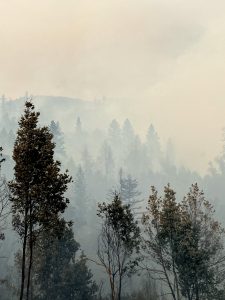
At the Dolan Fire, the morning mist gave way to afternoon heat while smoke choked my breath and pulled tears from my eyes. My forearms cramped my hands into claws, so I wrapped them around the chainsaw to continue cutting. As smoke billowed over the mountain ridge, we placed our trust in the senior firefighters. They had the experience to predict how the wildfire would behave next: where it would move, how quickly, and when we should retreat.
Wildland firefighters’ lives often depend on their ability to predict fire behavior. This acquired knowledge drives critical decisions about where to “cut line,” or create fuel breaks, how big the lines should be, and when to run. These predictions are built on baseline environmental assumptions: that temperatures will cool at night, that old fire scars rarely burn, and that fuel breaks will halt the flames’ spread. When these baseline assumptions are disrupted, firefighters lose the capacity to predict.
As a heat wave rolled through California’s warmest August in history, and temperatures soared above 110 degrees Fahrenheit, embers which had lain dormant in the underbrush were rekindled. The flames cast towers of smoke into the sky, billowing until the combined weight of the particulate matter caused the clouds to collapse on themselves, dispersing flaming material and creating new wind patterns. Similarly extreme fires have been known to generate wind speeds as high as 143 miles per hour, uprooting trees without even singeing them and tearing roofs from houses. In August, these conditions led the National Weather Service to issue its first-ever “fire tornado” warning.
In a matter of days, the Dolan Fire more than tripled in size, from 30,000 acres to 110,000. During rapid expansions, wildfires behave unpredictably, exploding in the night and jumping fuel breaks. As the Dolan Fire grew, it overtook an entire crew of firefighters in the early morning, a time when fires are usually calm. Fifteen firefighters were injured.
“The rise of the megafire is an anthropogenic phenomenon,” an environmental scientist recently told me. “It’s not just climate change, but climate change is intensifying everything.” Since 1990, the number of autumn days each year when California is under severe fire risk has doubled. Once anomalous, the combination of extreme conditions driving the current wildfires is quickly becoming the norm.
California’s ecosystems have been dependent on fire for most of their evolutionary history. According to the ecologist James Agee, “California has always been and will continue to be a fire environment unmatched in North America.” As much as 54% of California’s ecosystems actually require fire to remain intact. Historically, the plants in these regions have kindled the very flames they need.
In the slopes of the Sierra Nevada mountains, for example, centuries-old pine trees drop needles infused with flammable resin. This kindling coats the forest floor, allowing flames to creep low and slow among the undergrowth, eliminating competing vegetation. Thick bark at the base of the pines protects them from heat damage while the fire spreads over the ground, warming the soil, opening seed cones beneath the surface, and instigating their cycle of growth.
The more arid mountains of southern California are also home to plant species that store their seeds in the ground, but the parent plants incinerate themselves to release the seeds from dormancy. One unassuming shrub called chamise produces a highly flammable oil which, when ignited, instigates intense flames that leave mountain slopes scorched and bare. Within days, however, green buds poke through the carnage, germinating into a new generation of foliage.
In the right doses, and at the right intensity, fire is key to the health of California’s ecosystems. The problem now is that there are many kinds of fire, and California’s landscapes are experiencing less and less of the good kinds. The destructiveness of today’s fires, writes anthropologist Adriana Petryna, “obliges us to revise knowledge calibrated to conditions that no longer exist.”
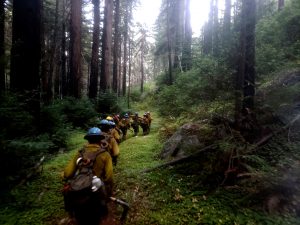
In August, several weeks before I was called to help fight the Dolan Fire, I entered the San Bernardino mountains behind Los Angeles with a group of ecologists to measure the flammability of the forest. Jeffrey pines rose a hundred feet overhead, filling the air with their distinctive aroma of sweet vanilla. The forest was quiet except for the rattle of woodpeckers and swish of wind in the canopy. Pinecones the size of my forearms lay scattered across a thick carpet of pine needles. I crawled on my stomach between the trees, measuring each piece of wood along a two-meter line.
“We have two-hundred one-hour fuels,” I shouted to Ryan, a mustached ecologist with a clipboard. Then I crawled back to begin counting thicker fuels, adding to a growing data set that forest ecologists were creating to measure the impact of a fire the Forest Service had intentionally set several months before. There were only four of us, with much information to gather: we counted each species of tree alive and dead, assessed the percentage of ground covered by debris, and measured the thickness of soil layers to a tenth of a centimeter.
All that data, we hoped, would provide a glimpse into what might happen if the Forest Service began conducting more prescribed burns. As the lead ecologist explained, this particular forest had evolved over millennia with fires every fifteen years, but it had not burned in more than a century. Prescribed burns will hopefully revive the historical pattern of frequent, light fires, protecting the region from the kind of large-scale conflagrations that can permanently erase forests.
The lack of fire has had a ripple effect, compounding the likelihood of large fires. Without frequent blazes to clear undergrowth, the forest has become more crowded. White fir trees, for example, thrive in the shade offered by Jeffrey pines, increasing competition for water. In a climate defined by extreme drought, this competition for water weakens trees, exacerbating forests’ vulnerability to pests such as bark beetles that are killing record numbers of trees throughout California.
Climate change, in turn, has expanded the range and season of the beetles, disrupting a careful ecological balance. “Beetle outbreaks have been happening for thousands of years,” according to entomologist Diana Six, “but this one is estimated to be more than 10 times bigger.” Hikers across the American West, from the forests of British Columbia to the alpine peaks of the Rockies and the granite slopes of the Sierras, will be familiar with the numb feeling of seeing dead trees span the horizon. Parched forests filled with flammable dead trees and crowded with vegetation can encourage fires to climb up to their vulnerable canopy, producing much more catastrophic conflagrations.
Since 1970, climate change has also lengthened California’s fire season by an average of 78 days each year. Meanwhile, heat waves sweep urban areas, driving more campers to the cool coniferous heights of forests like San Bernardino, where they light campfires that can easily escape. In these mountains, it is not a matter of if a fire will occur, but when. The ecologists I worked with wanted to ensure that when fires do occur, the forests — and communities within them — can survive.
Back in the San Bernardino mountains, our crew of ecologists paused for lunch under a giant Jeffrey pine. I chatted with Nicole Molinari, the head Forest Service ecologist in Southern California. “We like to call these sky islands,” Nicole said, gesturing at the forest around us. It was an apt metaphor. The mountain rose seven thousand feet from the coastal area, creating a conifer oasis in the sky. Below, shrublands and cityscape stretched in every direction. That level of isolation renders plant life precarious. “This means that when you get a high severity fire, the whole forest is gone,” she said. “There are no seed sources to re-seed it.”
The ecologists expressed hope that science will point to the best course of action for conserving forests, and they are devoted to the cause. To gather data, they often camp for weeks in rugged terrain, rising with the sun to spend twelve hours at a time systematically documenting every miniscule environmental detail. They contend with bears, tarantulas, scorpions, collapsed roads, and clouds of biting insects. One ecologist recounted stumbling upon an illegal marijuana operation, replete with assault rifles slung over nearby trees. Another described being attacked by a swarm of hornets while traversing a cliff. She remembers glissading down the scree to avoid the stings. Conditions are perilous: once, the ecologists returned to their radios to learn that a wildfire was roaring towards them. To escape, they hefted their heavy gear and ran up a mountain slope in triple-digit heat.
Although their expeditions often occur within fifty miles of Southern California’s coastal population hubs, the terrain can be so rugged that no humans have set foot on the ground for hundreds of years. Plant enthusiasts call these areas botanical black holes, where species of plants never documented by Western science likely exist. Ecologists enter such regions on foot, with mule trains, or sometimes by helicopter, but always with a gritty faith that their meticulous research will help restore the balance between fire, forests, and humans.
Even as scientific consensus emerges that prescribed burning in regionally appropriate ways will be important for both forests and communities to survive emerging environmental extremes, the physical act of setting fire to forests runs against several centuries of institutional, cultural, and climatic momentum.
Before prescribed burns are even lit, the sound of chainsaws in the forest can spark resistance from environmental organizations. This mechanical disruption is often a necessary first step towards ensuring that prescribed burns can be safely conducted: small trees and brush connecting the forest floor to the canopies must be removed before the fire is lit. But this practice arouses suspicion among those with strong notions of what is natural — chainsaws don’t seem to fit the description. Perhaps this is a reasonable suspicion, given the Forest Service’s dubious history of prioritizing the interests of logging corporations, but the delays resulting from this resistance, ironically, can spell the death of the very forests environmentalists clamor to protect.
And when prescribed burns do not foment outright opposition, the possibility of displacing endangered owls, amphibians, and other critters can create mountains of paperwork and years of delay. An ecologist I spoke with expressed frustration with this resistance, viewing it as shortsighted. While single-species protection is important, it can sometimes have the perverse effect of endangering the whole interconnected ecosystem necessary for its protection. “You can save one species for now, only to lose the whole forest and all the animals in the forest,” she said.
Making matters more complicated, prescribed burns occasionally escape control and threaten nearby houses. This does not inspire faith in the competency of government employees. In the event that a prescribed burn does go smoothly, other issues inevitably arise. Forest Service officials tell tales of monetary claims submitted from gated communities for the expense of visiting a car wash or having a pool cleaned to remove the film of ash that settles after a burn.
Aside from these obstacles, the increased climatic volatility of our carbon-infused environment constricts the window of time in which healthy fires can occur. Prescribed burns require very specific conditions: temperature, humidity, wind speed and direction, and moisture content of trees, plants, and ground fuel must fall within narrow parameters to diminish the possibility that the fire will escape control.
In the past, these factors typically aligned each winter, but climate change has made the requisite cold spells less and less frequent. In the mountains around San Diego, for instance, prescribed burns have produced promising results, but they cannot be lit after the oak trees have bloomed. The problem is, warming temperatures are causing oak trees to bloom earlier every year. The bloom time has retreated to the point that it overlaps with the burn period, impeding what little progress has been made in several decades of carefully managed burns.
The use of fire as a forest management tool has been hindered by a lack of funding, expertise, local support, and environmental stability. But political will has grown alongside scientific consensus about the benefits of the practice. In August, Governor Gavin Newsom committed to burning one million acres per year across the state by 2025. Many of these burns will be carried out by Indigenous communities working with the Forest Service to incorporate cultural fire techniques into forest management. In Northern California, the Yurok and Karuk tribes are preparing to implement traditional burn practices across a forested area one-and-a-half times the size of Rhode Island. If these developments are accompanied by rapid decarbonization, they have the potential to cap the destruction of wildfires in the future.
As I worked alongside the ecologists, measuring layers of dirt and thousands of sticks, rocks, and trunks, I gained a sense of the dedication and hard work that makes this even a possibility glimmering on the horizon. But between that possibility and the present, a harsher reality is rearing, and firefighters are tasked with containing it until a sustainable solution can be reached.
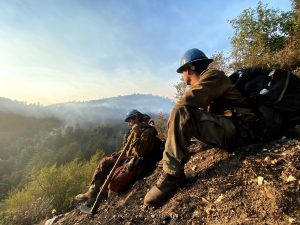
Around 5 PM that day on the Dolan Fire, I turned off my chainsaw to take a break. The terrain was so steep that it was difficult to sit, so I wedged my boots between the stubs of a few manzanita bushes that I had cut and rested awkwardly against the slope. But before I could catch my breath, a pop, crackle, and rush of smoke announced that the forest on an adjacent mountain had caught fire. A voice over the radio told us to “get out of there” in case the fire spread in our direction.
“I see the fires are starting again,” President Trump had noted several days prior at a rally in Pennsylvania. “I said you gotta clean your floors, you gotta clean your forests.” He threatened, “Maybe we’re just going to have to make them pay for it because they don’t listen to us.” Weeks later, when visiting California, the president denied the role of climate change in driving more extreme fire behavior. “I don’t think science knows, actually.”
In order to keep the fossil fuel industry competitive with renewables, the United States annually spends more than $600 billion in subsidies. Sarah Bloom Raskin, the former Deputy Secretary of the Treasury, says these investments forestall “the inevitable decline of an industry that can no longer sustain itself. If Trump is reelected in November and continues to prop up the industry, there are few ecological limits to how destructive wildfires will become.
The industry’s contraction since the Covid-19 pandemic presents what the International Energy Agency calls a “once in a lifetime opportunity” for governments to transfer subsidies away from fossil fuels and towards “a more resilient and cleaner energy future.” Though Joe Biden has promised to implement a plan that would eliminate carbon emissions from the power sector by 2035 and achieve net-zero emissions by 2050, there is no guarantee that a Democratic administration would enact such a transition. The Sunrise Movement, whose co-founder Varshini Prakesh joined Biden’s Climate Task Force, conceded that the candidate is now “talking the talk,” but that a significant post-election mobilization will be required to ensure that he will “walk the walk.”
The unprecedented severity of this year’s wildfires is a visceral reminder of the urgent need to decarbonize society, but climate change will not stop when the fires do. The planet is being remade each and every day, often quietly, at a scale and speed difficult to comprehend. When California stops burning this season, the ice caps will not stop melting, the oceans will continue to rise, heatwaves and droughts will continue displacing the world’s poor, and species will continue slipping into extinction at rates never seen in human history. The past is no longer a guide to the future. The question is how much environmental, economic, and humanitarian damage we are willing to accept.
But now, California is burning. As the sun began to set, my crew quickly descended the fireline we had spent the day cutting and marched towards the burning forest. A senior firefighter broke from our ranks and hurried toward the flames, holding them back with a hose until a helicopter arrived to dump water.
By dusk the flames were low enough for my crew to approach the fire’s edge and begin cutting a fuel break. Our headlights bobbed through the night, the forest pulsing orange as redwood trees torched. When my chainsaw ran out of fuel, I removed my earplugs for a moment to hear the trees. As it burned, the redwood forest rumbled like a train, or a waterfall, or ten thousand campfires condensed into one.
We returned to camp late that night, grabbing oranges from baskets the farmers left out for us. We slept on the ground. The next day, we woke before dawn to do it again.
Jordan Thomas is pursuing a PhD in anthropology at the University of California, Santa Barbara. He researches the cultural forces that shape fire.